Analysis of Community Healthcare and Nursing's Changing Practice
VerifiedAdded on 2023/04/22
|7
|1574
|340
Report
AI Summary
This report examines the evolving landscape of community healthcare and the expanding role of nurses in response to healthcare reform. It highlights the increasing prevalence of chronic ailments and the shift towards community-based care, including nurse-led clinics, medical homes, and accountable care organizations (ACOs). The report analyzes feedback from nurses, who acknowledge the growing need for community healthcare services and the importance of nurses in managing chronic conditions, promoting patient self-management, and advocating for policy changes. The analysis emphasizes the significance of continuity of care and the potential of community healthcare centers to improve patient outcomes and reduce healthcare costs. The report underscores the critical role of nurses in adapting to these changes and contributing to a more patient-centered and cost-effective healthcare system.
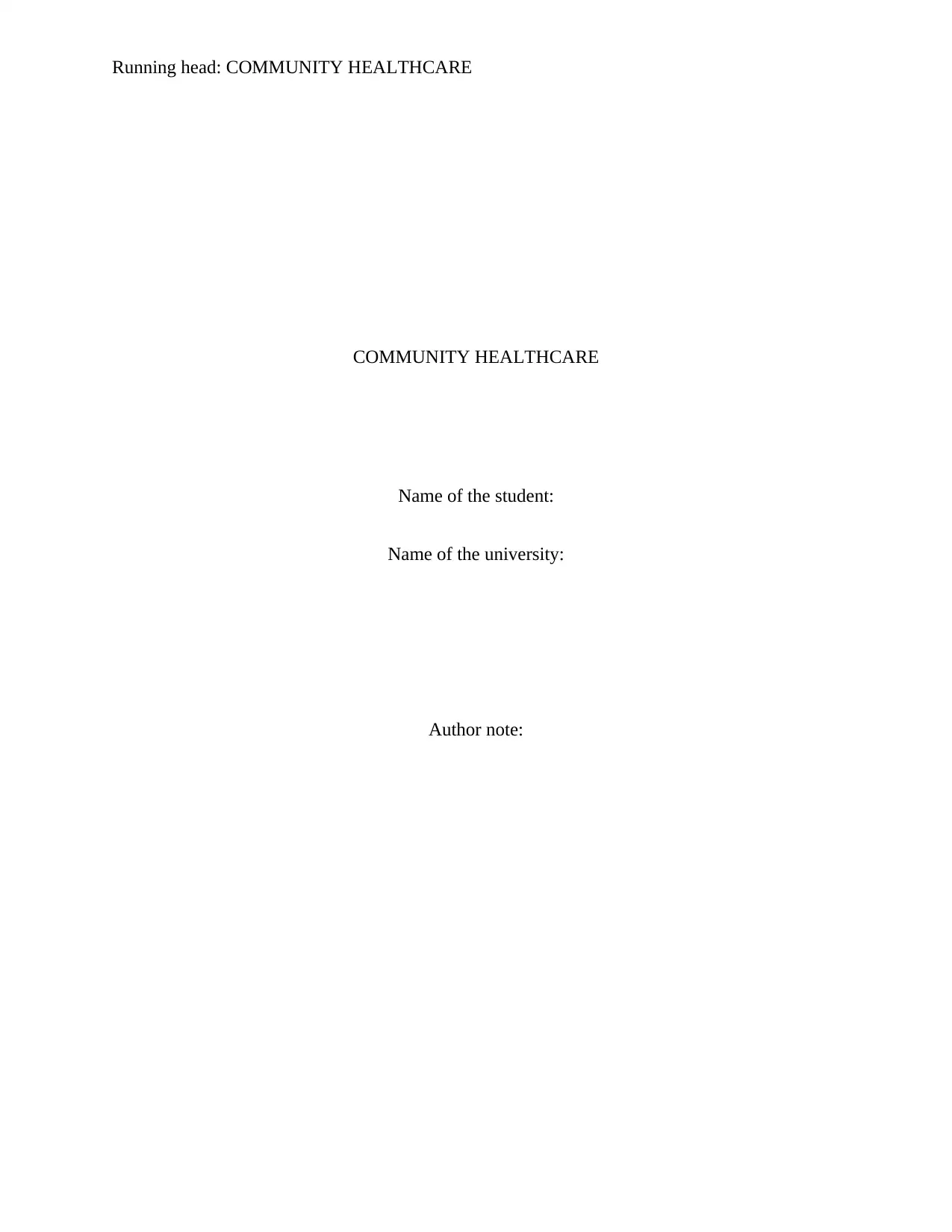
Running head: COMMUNITY HEALTHCARE
COMMUNITY HEALTHCARE
Name of the student:
Name of the university:
Author note:
COMMUNITY HEALTHCARE
Name of the student:
Name of the university:
Author note:
Paraphrase This Document
Need a fresh take? Get an instant paraphrase of this document with our AI Paraphraser
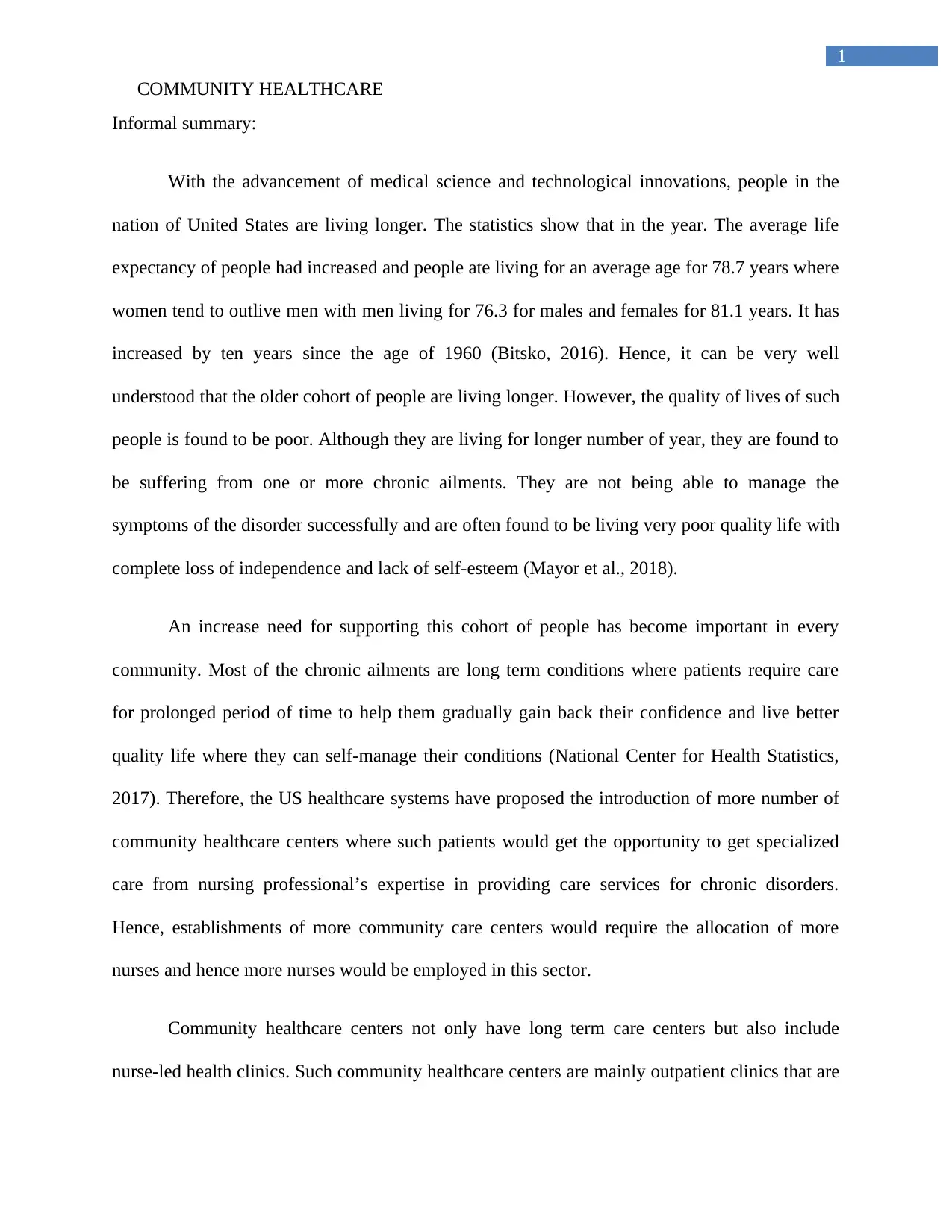
1
COMMUNITY HEALTHCARE
Informal summary:
With the advancement of medical science and technological innovations, people in the
nation of United States are living longer. The statistics show that in the year. The average life
expectancy of people had increased and people ate living for an average age for 78.7 years where
women tend to outlive men with men living for 76.3 for males and females for 81.1 years. It has
increased by ten years since the age of 1960 (Bitsko, 2016). Hence, it can be very well
understood that the older cohort of people are living longer. However, the quality of lives of such
people is found to be poor. Although they are living for longer number of year, they are found to
be suffering from one or more chronic ailments. They are not being able to manage the
symptoms of the disorder successfully and are often found to be living very poor quality life with
complete loss of independence and lack of self-esteem (Mayor et al., 2018).
An increase need for supporting this cohort of people has become important in every
community. Most of the chronic ailments are long term conditions where patients require care
for prolonged period of time to help them gradually gain back their confidence and live better
quality life where they can self-manage their conditions (National Center for Health Statistics,
2017). Therefore, the US healthcare systems have proposed the introduction of more number of
community healthcare centers where such patients would get the opportunity to get specialized
care from nursing professional’s expertise in providing care services for chronic disorders.
Hence, establishments of more community care centers would require the allocation of more
nurses and hence more nurses would be employed in this sector.
Community healthcare centers not only have long term care centers but also include
nurse-led health clinics. Such community healthcare centers are mainly outpatient clinics that are
COMMUNITY HEALTHCARE
Informal summary:
With the advancement of medical science and technological innovations, people in the
nation of United States are living longer. The statistics show that in the year. The average life
expectancy of people had increased and people ate living for an average age for 78.7 years where
women tend to outlive men with men living for 76.3 for males and females for 81.1 years. It has
increased by ten years since the age of 1960 (Bitsko, 2016). Hence, it can be very well
understood that the older cohort of people are living longer. However, the quality of lives of such
people is found to be poor. Although they are living for longer number of year, they are found to
be suffering from one or more chronic ailments. They are not being able to manage the
symptoms of the disorder successfully and are often found to be living very poor quality life with
complete loss of independence and lack of self-esteem (Mayor et al., 2018).
An increase need for supporting this cohort of people has become important in every
community. Most of the chronic ailments are long term conditions where patients require care
for prolonged period of time to help them gradually gain back their confidence and live better
quality life where they can self-manage their conditions (National Center for Health Statistics,
2017). Therefore, the US healthcare systems have proposed the introduction of more number of
community healthcare centers where such patients would get the opportunity to get specialized
care from nursing professional’s expertise in providing care services for chronic disorders.
Hence, establishments of more community care centers would require the allocation of more
nurses and hence more nurses would be employed in this sector.
Community healthcare centers not only have long term care centers but also include
nurse-led health clinics. Such community healthcare centers are mainly outpatient clinics that are
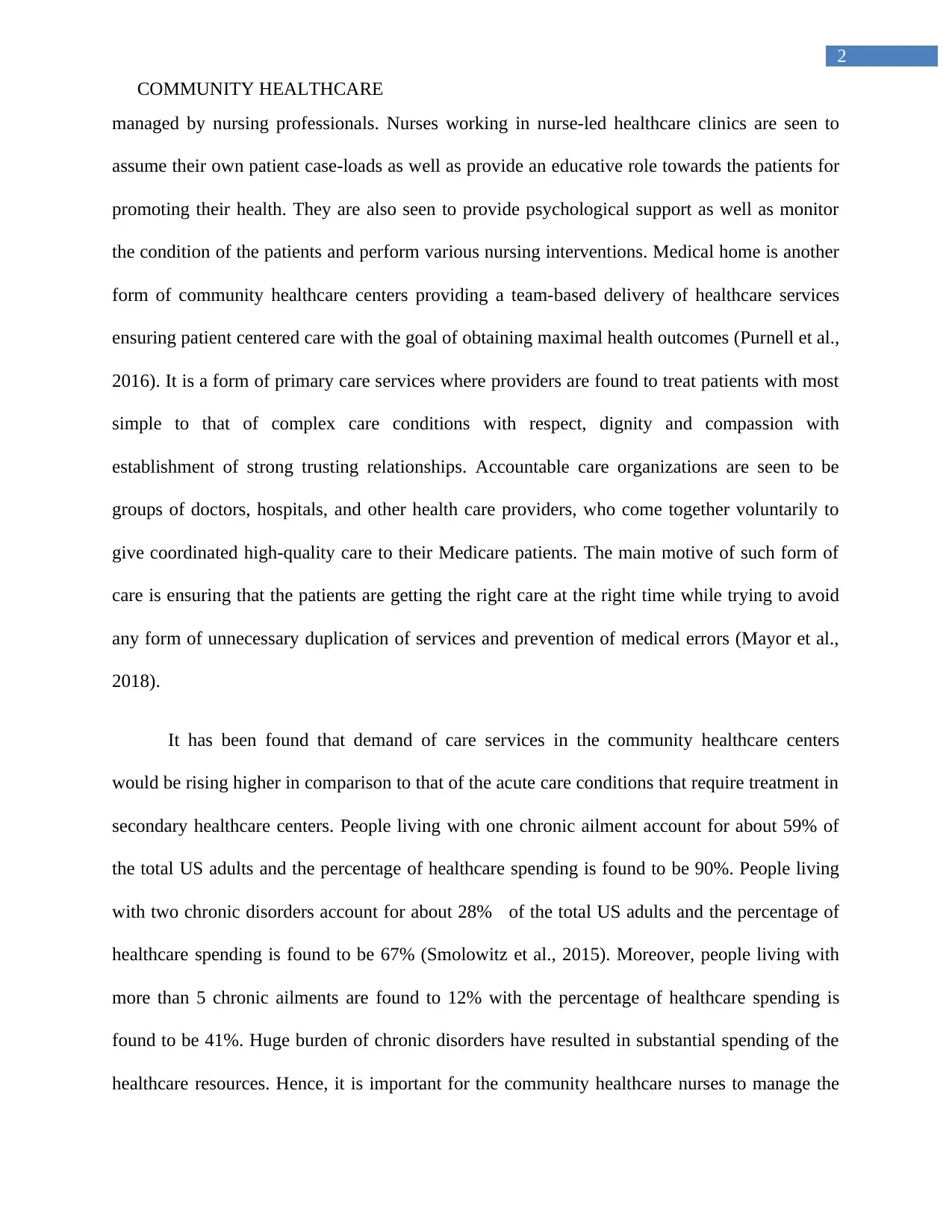
2
COMMUNITY HEALTHCARE
managed by nursing professionals. Nurses working in nurse-led healthcare clinics are seen to
assume their own patient case-loads as well as provide an educative role towards the patients for
promoting their health. They are also seen to provide psychological support as well as monitor
the condition of the patients and perform various nursing interventions. Medical home is another
form of community healthcare centers providing a team-based delivery of healthcare services
ensuring patient centered care with the goal of obtaining maximal health outcomes (Purnell et al.,
2016). It is a form of primary care services where providers are found to treat patients with most
simple to that of complex care conditions with respect, dignity and compassion with
establishment of strong trusting relationships. Accountable care organizations are seen to be
groups of doctors, hospitals, and other health care providers, who come together voluntarily to
give coordinated high-quality care to their Medicare patients. The main motive of such form of
care is ensuring that the patients are getting the right care at the right time while trying to avoid
any form of unnecessary duplication of services and prevention of medical errors (Mayor et al.,
2018).
It has been found that demand of care services in the community healthcare centers
would be rising higher in comparison to that of the acute care conditions that require treatment in
secondary healthcare centers. People living with one chronic ailment account for about 59% of
the total US adults and the percentage of healthcare spending is found to be 90%. People living
with two chronic disorders account for about 28% of the total US adults and the percentage of
healthcare spending is found to be 67% (Smolowitz et al., 2015). Moreover, people living with
more than 5 chronic ailments are found to 12% with the percentage of healthcare spending is
found to be 41%. Huge burden of chronic disorders have resulted in substantial spending of the
healthcare resources. Hence, it is important for the community healthcare nurses to manage the
COMMUNITY HEALTHCARE
managed by nursing professionals. Nurses working in nurse-led healthcare clinics are seen to
assume their own patient case-loads as well as provide an educative role towards the patients for
promoting their health. They are also seen to provide psychological support as well as monitor
the condition of the patients and perform various nursing interventions. Medical home is another
form of community healthcare centers providing a team-based delivery of healthcare services
ensuring patient centered care with the goal of obtaining maximal health outcomes (Purnell et al.,
2016). It is a form of primary care services where providers are found to treat patients with most
simple to that of complex care conditions with respect, dignity and compassion with
establishment of strong trusting relationships. Accountable care organizations are seen to be
groups of doctors, hospitals, and other health care providers, who come together voluntarily to
give coordinated high-quality care to their Medicare patients. The main motive of such form of
care is ensuring that the patients are getting the right care at the right time while trying to avoid
any form of unnecessary duplication of services and prevention of medical errors (Mayor et al.,
2018).
It has been found that demand of care services in the community healthcare centers
would be rising higher in comparison to that of the acute care conditions that require treatment in
secondary healthcare centers. People living with one chronic ailment account for about 59% of
the total US adults and the percentage of healthcare spending is found to be 90%. People living
with two chronic disorders account for about 28% of the total US adults and the percentage of
healthcare spending is found to be 67% (Smolowitz et al., 2015). Moreover, people living with
more than 5 chronic ailments are found to 12% with the percentage of healthcare spending is
found to be 41%. Huge burden of chronic disorders have resulted in substantial spending of the
healthcare resources. Hence, it is important for the community healthcare nurses to manage the
⊘ This is a preview!⊘
Do you want full access?
Subscribe today to unlock all pages.

Trusted by 1+ million students worldwide
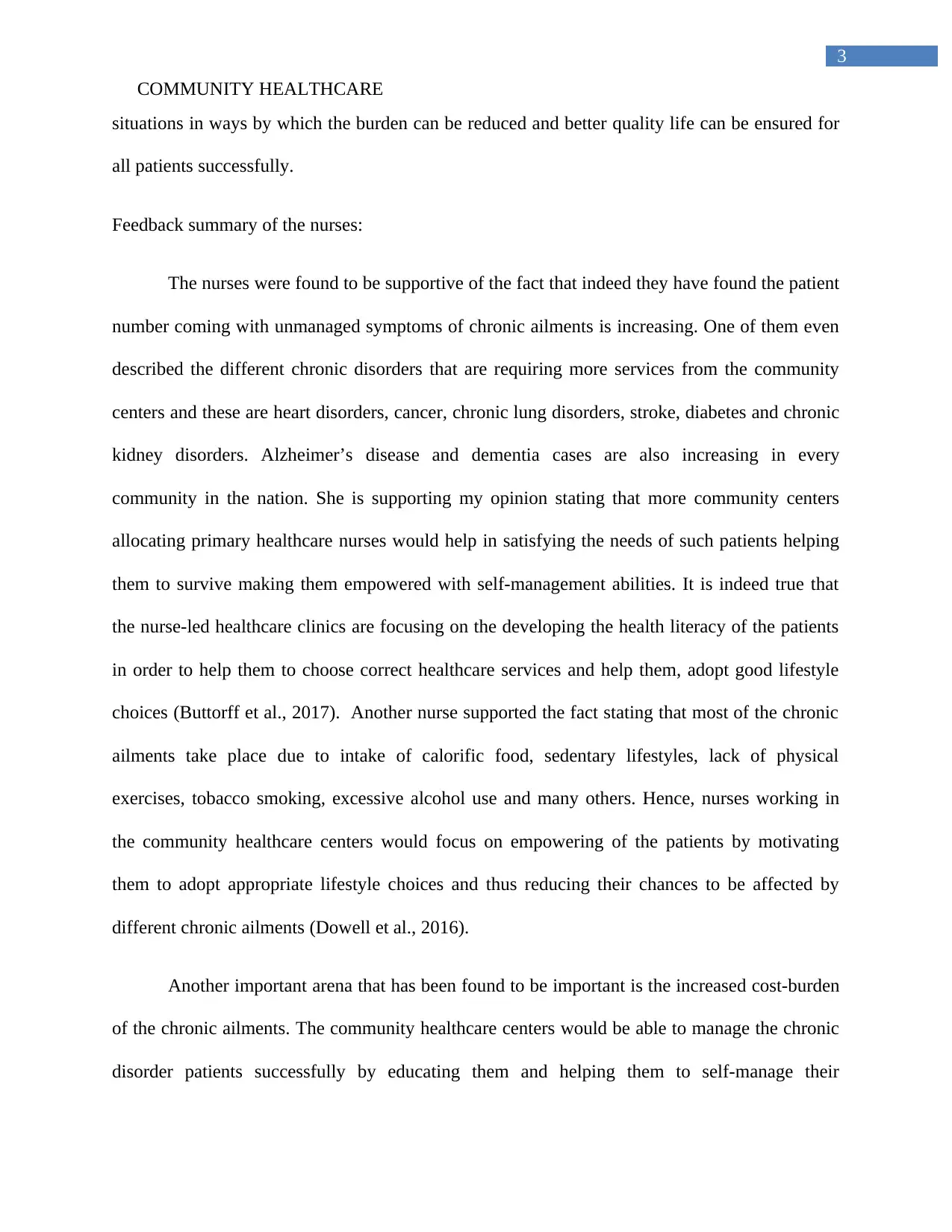
3
COMMUNITY HEALTHCARE
situations in ways by which the burden can be reduced and better quality life can be ensured for
all patients successfully.
Feedback summary of the nurses:
The nurses were found to be supportive of the fact that indeed they have found the patient
number coming with unmanaged symptoms of chronic ailments is increasing. One of them even
described the different chronic disorders that are requiring more services from the community
centers and these are heart disorders, cancer, chronic lung disorders, stroke, diabetes and chronic
kidney disorders. Alzheimer’s disease and dementia cases are also increasing in every
community in the nation. She is supporting my opinion stating that more community centers
allocating primary healthcare nurses would help in satisfying the needs of such patients helping
them to survive making them empowered with self-management abilities. It is indeed true that
the nurse-led healthcare clinics are focusing on the developing the health literacy of the patients
in order to help them to choose correct healthcare services and help them, adopt good lifestyle
choices (Buttorff et al., 2017). Another nurse supported the fact stating that most of the chronic
ailments take place due to intake of calorific food, sedentary lifestyles, lack of physical
exercises, tobacco smoking, excessive alcohol use and many others. Hence, nurses working in
the community healthcare centers would focus on empowering of the patients by motivating
them to adopt appropriate lifestyle choices and thus reducing their chances to be affected by
different chronic ailments (Dowell et al., 2016).
Another important arena that has been found to be important is the increased cost-burden
of the chronic ailments. The community healthcare centers would be able to manage the chronic
disorder patients successfully by educating them and helping them to self-manage their
COMMUNITY HEALTHCARE
situations in ways by which the burden can be reduced and better quality life can be ensured for
all patients successfully.
Feedback summary of the nurses:
The nurses were found to be supportive of the fact that indeed they have found the patient
number coming with unmanaged symptoms of chronic ailments is increasing. One of them even
described the different chronic disorders that are requiring more services from the community
centers and these are heart disorders, cancer, chronic lung disorders, stroke, diabetes and chronic
kidney disorders. Alzheimer’s disease and dementia cases are also increasing in every
community in the nation. She is supporting my opinion stating that more community centers
allocating primary healthcare nurses would help in satisfying the needs of such patients helping
them to survive making them empowered with self-management abilities. It is indeed true that
the nurse-led healthcare clinics are focusing on the developing the health literacy of the patients
in order to help them to choose correct healthcare services and help them, adopt good lifestyle
choices (Buttorff et al., 2017). Another nurse supported the fact stating that most of the chronic
ailments take place due to intake of calorific food, sedentary lifestyles, lack of physical
exercises, tobacco smoking, excessive alcohol use and many others. Hence, nurses working in
the community healthcare centers would focus on empowering of the patients by motivating
them to adopt appropriate lifestyle choices and thus reducing their chances to be affected by
different chronic ailments (Dowell et al., 2016).
Another important arena that has been found to be important is the increased cost-burden
of the chronic ailments. The community healthcare centers would be able to manage the chronic
disorder patients successfully by educating them and helping them to self-manage their
Paraphrase This Document
Need a fresh take? Get an instant paraphrase of this document with our AI Paraphraser
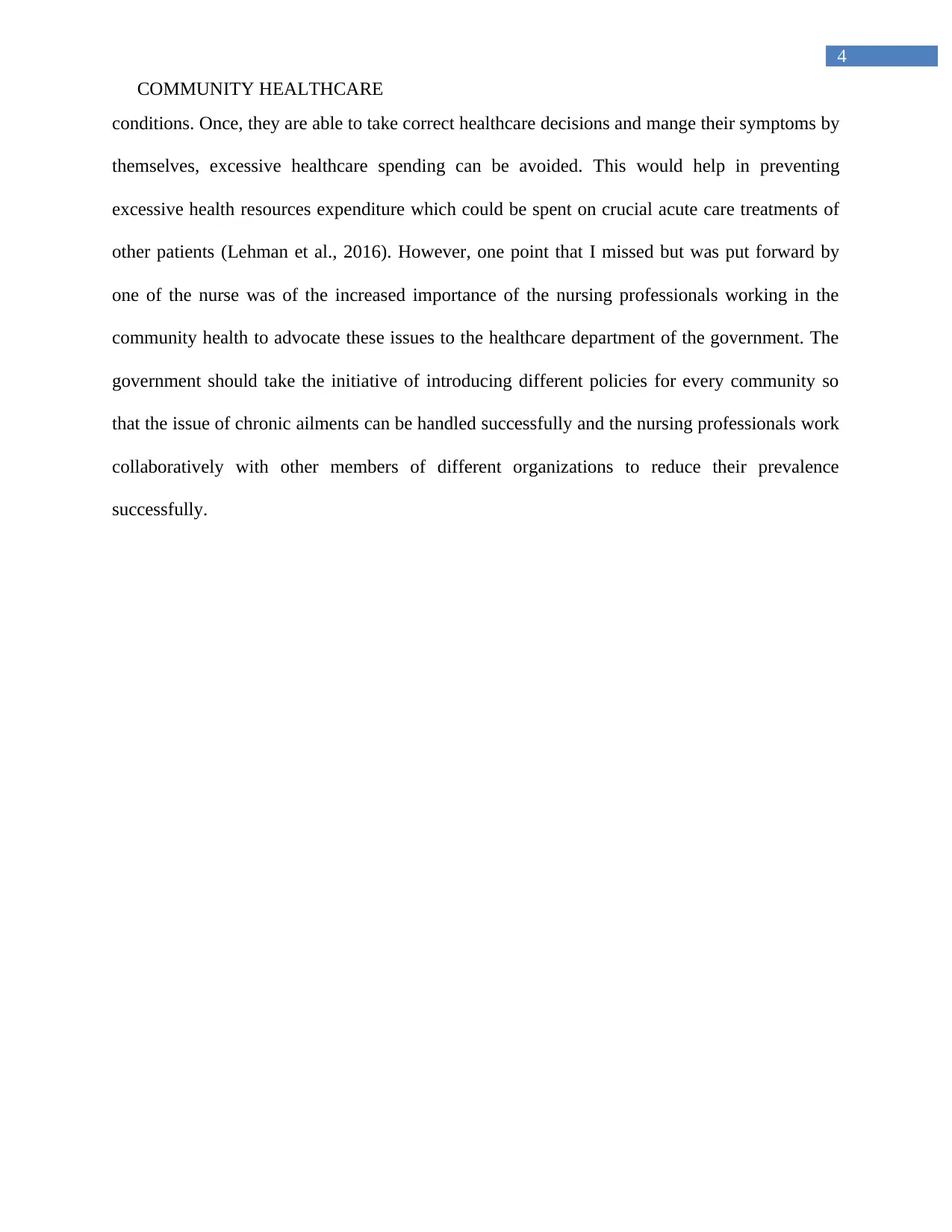
4
COMMUNITY HEALTHCARE
conditions. Once, they are able to take correct healthcare decisions and mange their symptoms by
themselves, excessive healthcare spending can be avoided. This would help in preventing
excessive health resources expenditure which could be spent on crucial acute care treatments of
other patients (Lehman et al., 2016). However, one point that I missed but was put forward by
one of the nurse was of the increased importance of the nursing professionals working in the
community health to advocate these issues to the healthcare department of the government. The
government should take the initiative of introducing different policies for every community so
that the issue of chronic ailments can be handled successfully and the nursing professionals work
collaboratively with other members of different organizations to reduce their prevalence
successfully.
COMMUNITY HEALTHCARE
conditions. Once, they are able to take correct healthcare decisions and mange their symptoms by
themselves, excessive healthcare spending can be avoided. This would help in preventing
excessive health resources expenditure which could be spent on crucial acute care treatments of
other patients (Lehman et al., 2016). However, one point that I missed but was put forward by
one of the nurse was of the increased importance of the nursing professionals working in the
community health to advocate these issues to the healthcare department of the government. The
government should take the initiative of introducing different policies for every community so
that the issue of chronic ailments can be handled successfully and the nursing professionals work
collaboratively with other members of different organizations to reduce their prevalence
successfully.
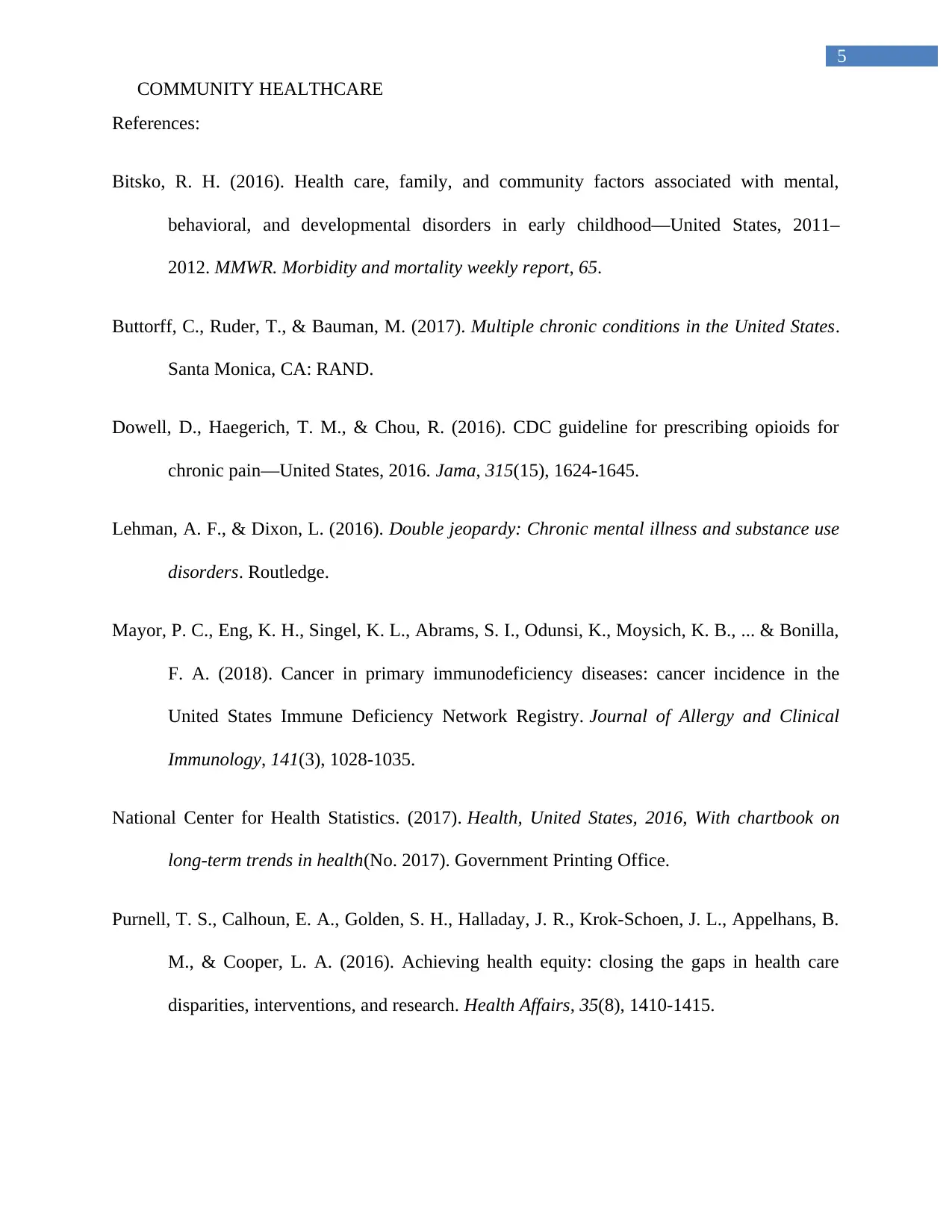
5
COMMUNITY HEALTHCARE
References:
Bitsko, R. H. (2016). Health care, family, and community factors associated with mental,
behavioral, and developmental disorders in early childhood—United States, 2011–
2012. MMWR. Morbidity and mortality weekly report, 65.
Buttorff, C., Ruder, T., & Bauman, M. (2017). Multiple chronic conditions in the United States.
Santa Monica, CA: RAND.
Dowell, D., Haegerich, T. M., & Chou, R. (2016). CDC guideline for prescribing opioids for
chronic pain—United States, 2016. Jama, 315(15), 1624-1645.
Lehman, A. F., & Dixon, L. (2016). Double jeopardy: Chronic mental illness and substance use
disorders. Routledge.
Mayor, P. C., Eng, K. H., Singel, K. L., Abrams, S. I., Odunsi, K., Moysich, K. B., ... & Bonilla,
F. A. (2018). Cancer in primary immunodeficiency diseases: cancer incidence in the
United States Immune Deficiency Network Registry. Journal of Allergy and Clinical
Immunology, 141(3), 1028-1035.
National Center for Health Statistics. (2017). Health, United States, 2016, With chartbook on
long-term trends in health(No. 2017). Government Printing Office.
Purnell, T. S., Calhoun, E. A., Golden, S. H., Halladay, J. R., Krok-Schoen, J. L., Appelhans, B.
M., & Cooper, L. A. (2016). Achieving health equity: closing the gaps in health care
disparities, interventions, and research. Health Affairs, 35(8), 1410-1415.
COMMUNITY HEALTHCARE
References:
Bitsko, R. H. (2016). Health care, family, and community factors associated with mental,
behavioral, and developmental disorders in early childhood—United States, 2011–
2012. MMWR. Morbidity and mortality weekly report, 65.
Buttorff, C., Ruder, T., & Bauman, M. (2017). Multiple chronic conditions in the United States.
Santa Monica, CA: RAND.
Dowell, D., Haegerich, T. M., & Chou, R. (2016). CDC guideline for prescribing opioids for
chronic pain—United States, 2016. Jama, 315(15), 1624-1645.
Lehman, A. F., & Dixon, L. (2016). Double jeopardy: Chronic mental illness and substance use
disorders. Routledge.
Mayor, P. C., Eng, K. H., Singel, K. L., Abrams, S. I., Odunsi, K., Moysich, K. B., ... & Bonilla,
F. A. (2018). Cancer in primary immunodeficiency diseases: cancer incidence in the
United States Immune Deficiency Network Registry. Journal of Allergy and Clinical
Immunology, 141(3), 1028-1035.
National Center for Health Statistics. (2017). Health, United States, 2016, With chartbook on
long-term trends in health(No. 2017). Government Printing Office.
Purnell, T. S., Calhoun, E. A., Golden, S. H., Halladay, J. R., Krok-Schoen, J. L., Appelhans, B.
M., & Cooper, L. A. (2016). Achieving health equity: closing the gaps in health care
disparities, interventions, and research. Health Affairs, 35(8), 1410-1415.
⊘ This is a preview!⊘
Do you want full access?
Subscribe today to unlock all pages.

Trusted by 1+ million students worldwide
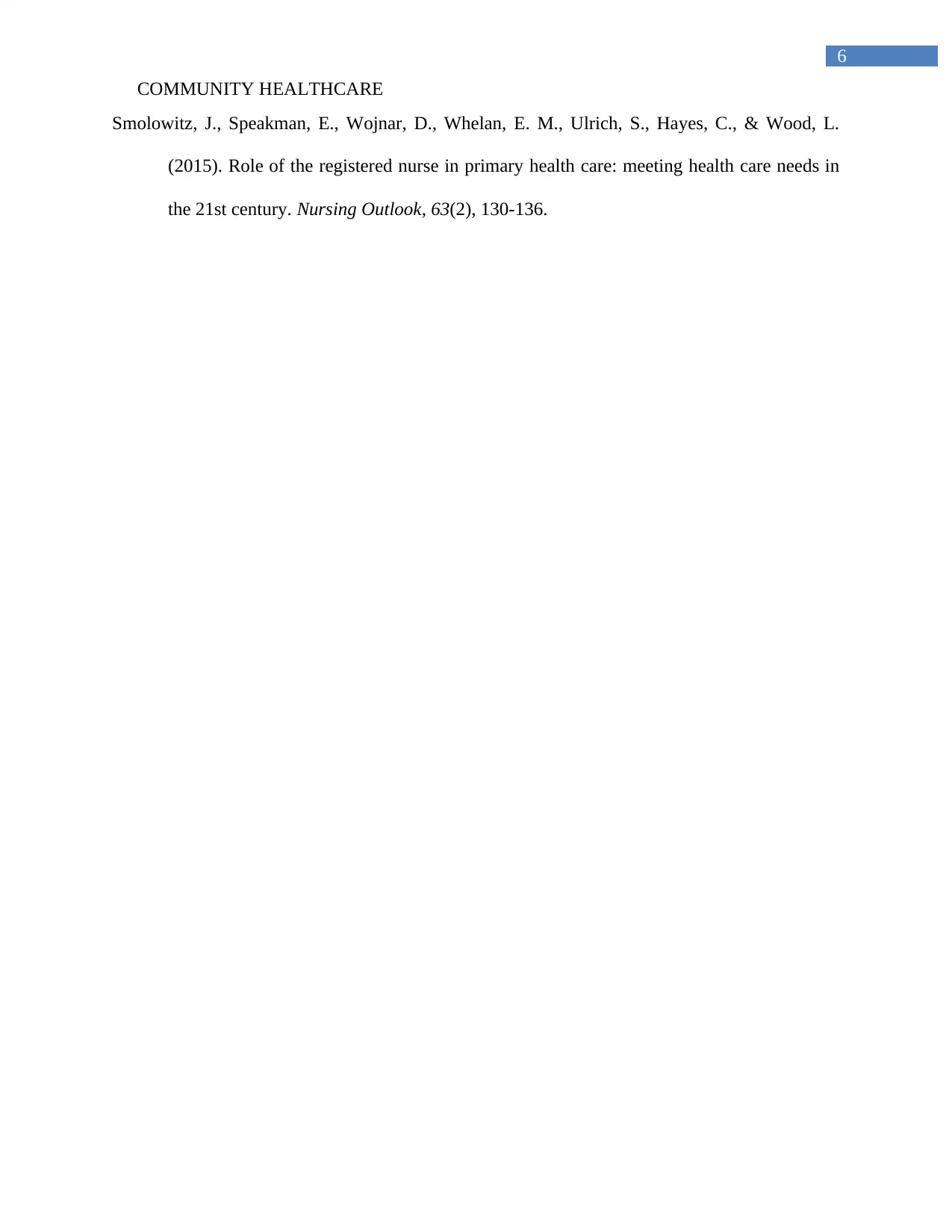
6
COMMUNITY HEALTHCARE
Smolowitz, J., Speakman, E., Wojnar, D., Whelan, E. M., Ulrich, S., Hayes, C., & Wood, L.
(2015). Role of the registered nurse in primary health care: meeting health care needs in
the 21st century. Nursing Outlook, 63(2), 130-136.
COMMUNITY HEALTHCARE
Smolowitz, J., Speakman, E., Wojnar, D., Whelan, E. M., Ulrich, S., Hayes, C., & Wood, L.
(2015). Role of the registered nurse in primary health care: meeting health care needs in
the 21st century. Nursing Outlook, 63(2), 130-136.
1 out of 7
Related Documents
Your All-in-One AI-Powered Toolkit for Academic Success.
+13062052269
info@desklib.com
Available 24*7 on WhatsApp / Email
![[object Object]](/_next/static/media/star-bottom.7253800d.svg)
Unlock your academic potential
Copyright © 2020–2025 A2Z Services. All Rights Reserved. Developed and managed by ZUCOL.





